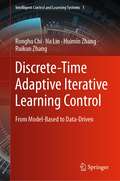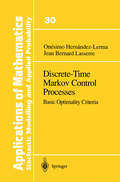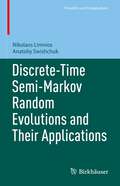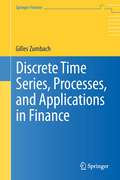- Table View
- List View
Discrete Spectral Synthesis and Its Applications (Springer Monographs in Mathematics)
by László SzékelyhidiThis book studies the situation over discrete Abelian groups with wide range applications. It covers classical functional equations, difference and differential equations, polynomial ideals, digital filtering and polynomial hypergroups, giving unified treatment of several different problems. There is no other comprehensive work in this field. The book will be of interest to graduate students, research workers in harmonic analysis, spectral analysis, functional equations and hypergroups.
Discrete Stochastic Models and Applications for Reliability Engineering and Statistical Quality Control
by Serkan EryilmazDiscrete stochastic models are tools that allow us to understand, control, and optimize engineering systems and processes. This book provides real-life examples and illustrations of models in reliability engineering and statistical quality control and establishes a connection between the theoretical framework and their engineering applications. The book describes discrete stochastic models along with real-life examples and explores not only well-known models, but also comparatively lesser known ones. It includes definitions, concepts, and methods with a clear understanding of their use in reliability engineering and statistical quality control fields. Also covered are the recent advances and established connections between the theoretical framework of discrete stochastic models and their engineering applications. An ideal reference for researchers in academia and graduate students working in the fields of operations research, reliability engineering, quality control, and probability and statistics.
Discrete Stochastic Models and Applications for Reliability Engineering and Statistical Quality Control
by Serkan EryilmazDiscrete stochastic models are tools that allow us to understand, control, and optimize engineering systems and processes. This book provides real-life examples and illustrations of models in reliability engineering and statistical quality control and establishes a connection between the theoretical framework and their engineering applications. The book describes discrete stochastic models along with real-life examples and explores not only well-known models, but also comparatively lesser known ones. It includes definitions, concepts, and methods with a clear understanding of their use in reliability engineering and statistical quality control fields. Also covered are the recent advances and established connections between the theoretical framework of discrete stochastic models and their engineering applications. An ideal reference for researchers in academia and graduate students working in the fields of operations research, reliability engineering, quality control, and probability and statistics.
Discrete Stochastic Processes and Applications (Universitext)
by Jean-François ColletThis unique text for beginning graduate students gives a self-contained introduction to the mathematical properties of stochastics and presents their applications to Markov processes, coding theory, population dynamics, and search engine design. The book is ideal for a newly designed course in an introduction to probability and information theory. Prerequisites include working knowledge of linear algebra, calculus, and probability theory. The first part of the text focuses on the rigorous theory of Markov processes on countable spaces (Markov chains) and provides the basis to developing solid probabilistic intuition without the need for a course in measure theory. The approach taken is gradual beginning with the case of discrete time and moving on to that of continuous time. The second part of this text is more applied; its core introduces various uses of convexity in probability and presents a nice treatment of entropy.
Discrete Stochastics
by Konrad JacobsDiscrete stochastics is the theory of discrete probability spaces. This undergraduate textbook gives a concise introduction into discrete stochastics in general, and into a variety of typical special topics in this field, such as information theory, fluctuation theory, and semigroups of stochastic matrices. The emphasis lies on probability theory rather than on statistical methodology. Motivations, interpretations, and numerous examples and exercises relate the mathematical theory to stochastic experience.
Discrete Structures and Their Interactions (Discrete Mathematics And Its Applications Ser.)
by Jason I. BrownDiscover the Connections between Different Structures and FieldsDiscrete Structures and Their Interactions highlights the connections among various discrete structures, including graphs, directed graphs, hypergraphs, partial orders, finite topologies, and simplicial complexes. It also explores their relationships to classical areas of mathematics,
Discrete Structures and Their Interactions
by Jason I. BrownDiscover the Connections between Different Structures and FieldsDiscrete Structures and Their Interactions highlights the connections among various discrete structures, including graphs, directed graphs, hypergraphs, partial orders, finite topologies, and simplicial complexes. It also explores their relationships to classical areas of mathematics,
Discrete Thoughts: Essays on Mathematics, Science and Philosophy
by Mark Kac Gian-Carlo Rota Jacob T. SchwartzThis is a volume of essays and reviews that delightfully explores mathematics in all its moods — from the light and the witty, and humorous to serious, rational, and cerebral. These beautifully written articles from three great modern mathematicians will provide a source for supplemental reading for almost any math class. Topics include: logic, combinatorics, statistics, economics, artificial intelligence, computer science, and broad applications of mathematics. Readers will also find coverage of history and philosophy, including discussion of the work of Ulam, Kant, and Heidegger, among others.
Discrete Thoughts: ESSAYS ON MATHEMATICS, Science, and Philosophy (pdf) (Modern Birkhäuser Classics Ser.)
by Kac Rota SchwartzDiscrete-Time Adaptive Iterative Learning Control: From Model-Based to Data-Driven (Intelligent Control and Learning Systems #1)
by Ronghu Chi Na Lin Huimin Zhang Ruikun ZhangThis book belongs to the subject of control and systems theory. The discrete-time adaptive iterative learning control (DAILC) is discussed as a cutting-edge of ILC and can address random initial states, iteration-varying targets, and other non-repetitive uncertainties in practical applications. This book begins with the design and analysis of model-based DAILC methods by referencing the tools used in the discrete-time adaptive control theory. To overcome the extreme difficulties in modeling a complex system, the data-driven DAILC methods are further discussed by building a linear parametric data mapping between two consecutive iterations. Other significant improvements and extensions of the model-based/data-driven DAILC are also studied to facilitate broader applications. The readers can learn the recent progress on DAILC with consideration of various applications. This book is intended for academic scholars, engineers and graduate students who are interested in learning control, adaptive control, nonlinear systems, and related fields.
Discrete-Time and Discrete-Space Dynamical Systems (Communications and Control Engineering)
by Kuize Zhang Lijun Zhang Lihua XieDiscrete-Time and Discrete-Space Dynamical Systems provides a systematic characterization of the similarities and differences of several types of discrete-time and discrete-space dynamical systems, including:Boolean control networks;nondeterministic finite-transition systems;finite automata;labelled Petri nets; andcellular automata.The book's perspective is primarily based on topological properties though it also employs semitensor-product and graph-theoretic methods where appropriate. It presents a series of fundamental results: invertibility, observability, detectability, reversiblity, etc., with applications to systems biology.Academic researchers with backgrounds in applied mathematics, engineering or computer science and practising engineers working with discrete-time and discrete-space systems will find this book a helpful source of new understanding for this increasingly important class of systems. The basic results to be found within are of fundamental importance for further study of related problems such as automated synthesis and safety control in cyber-physical systems using formal methods.
Discrete-time Asset Pricing Models in Applied Stochastic Finance (Iste Ser.)
by P. C. VassiliouStochastic finance and financial engineering have been rapidly expanding fields of science over the past four decades, mainly due to the success of sophisticated quantitative methodologies in helping professionals manage financial risks. In recent years, we have witnessed a tremendous acceleration in research efforts aimed at better comprehending, modeling and hedging this kind of risk. These two volumes aim to provide a foundation course on applied stochastic finance. They are designed for three groups of readers: firstly, students of various backgrounds seeking a core knowledge on the subject of stochastic finance; secondly financial analysts and practitioners in the investment, banking and insurance industries; and finally other professionals who are interested in learning advanced mathematical and stochastic methods, which are basic knowledge in many areas, through finance. Volume 1 starts with the introduction of the basic financial instruments and the fundamental principles of financial modeling and arbitrage valuation of derivatives. Next, we use the discrete-time binomial model to introduce all relevant concepts. The mathematical simplicity of the binomial model also provides us with the opportunity to introduce and discuss in depth concepts such as conditional expectations and martingales in discrete time. However, we do not expand beyond the needs of the stochastic finance framework. Numerous examples, each highlighted and isolated from the text for easy reference and identification, are included. The book concludes with the use of the binomial model to introduce interest rate models and the use of the Markov chain model to introduce credit risk. This volume is designed in such a way that, among other uses, makes it useful as an undergraduate course.
Discrete-time Asset Pricing Models in Applied Stochastic Finance
by P. C. VassiliouStochastic finance and financial engineering have been rapidly expanding fields of science over the past four decades, mainly due to the success of sophisticated quantitative methodologies in helping professionals manage financial risks. In recent years, we have witnessed a tremendous acceleration in research efforts aimed at better comprehending, modeling and hedging this kind of risk. These two volumes aim to provide a foundation course on applied stochastic finance. They are designed for three groups of readers: firstly, students of various backgrounds seeking a core knowledge on the subject of stochastic finance; secondly financial analysts and practitioners in the investment, banking and insurance industries; and finally other professionals who are interested in learning advanced mathematical and stochastic methods, which are basic knowledge in many areas, through finance. Volume 1 starts with the introduction of the basic financial instruments and the fundamental principles of financial modeling and arbitrage valuation of derivatives. Next, we use the discrete-time binomial model to introduce all relevant concepts. The mathematical simplicity of the binomial model also provides us with the opportunity to introduce and discuss in depth concepts such as conditional expectations and martingales in discrete time. However, we do not expand beyond the needs of the stochastic finance framework. Numerous examples, each highlighted and isolated from the text for easy reference and identification, are included. The book concludes with the use of the binomial model to introduce interest rate models and the use of the Markov chain model to introduce credit risk. This volume is designed in such a way that, among other uses, makes it useful as an undergraduate course.
Discrete Time Branching Processes in Random Environment
by Götz Kersting Vladimir VatutinBranching processes are stochastic processes which represent the reproduction of particles, such as individuals within a population, and thereby model demographic stochasticity. In branching processes in random environment (BPREs), additional environmental stochasticity is incorporated, meaning that the conditions of reproduction may vary in a random fashion from one generation to the next. This book offers an introduction to the basics of BPREs and then presents the cases of critical and subcritical processes in detail, the latter dividing into weakly, intermediate, and strongly subcritical regimes.
Discrete Time Branching Processes in Random Environment
by Götz Kersting Vladimir VatutinBranching processes are stochastic processes which represent the reproduction of particles, such as individuals within a population, and thereby model demographic stochasticity. In branching processes in random environment (BPREs), additional environmental stochasticity is incorporated, meaning that the conditions of reproduction may vary in a random fashion from one generation to the next. This book offers an introduction to the basics of BPREs and then presents the cases of critical and subcritical processes in detail, the latter dividing into weakly, intermediate, and strongly subcritical regimes.
Discrete-time Dynamic Models (Topics in Chemical Engineering)
by Ronald K. PearsonFueled by advances in computer technology, model-based approaches to the control of industrial processes are now widespread. While there is an enormous literature on modeling, the difficult first step of selecting an appropriate model structure has received almost no attention. This book fills the gap, providing practical insight into model selection for chemical processes and emphasizing structures suitable for control system design.
Discrete-Time High Order Neural Control: Trained with Kalman Filtering (Studies in Computational Intelligence)
by Edgar N. Sanchez Alma Y. Alanís Alexander G. LoukianovNeural networks have become a well-established methodology as exempli?ed by their applications to identi?cation and control of general nonlinear and complex systems; the use of high order neural networks for modeling and learning has recently increased. Usingneuralnetworks,controlalgorithmscanbedevelopedtoberobustto uncertainties and modeling errors. The most used NN structures are Feedf- ward networks and Recurrent networks. The latter type o?ers a better suited tool to model and control of nonlinear systems. There exist di?erent training algorithms for neural networks, which, h- ever, normally encounter some technical problems such as local minima, slow learning, and high sensitivity to initial conditions, among others. As a viable alternative, new training algorithms, for example, those based on Kalman ?ltering, have been proposed. There already exists publications about trajectory tracking using neural networks; however, most of those works were developed for continuous-time systems. On the other hand, while extensive literature is available for linear discrete-timecontrolsystem,nonlineardiscrete-timecontroldesigntechniques have not been discussed to the same degree. Besides, discrete-time neural networks are better ?tted for real-time implementations.
Discrete-Time Linear Systems: Theory and Design with Applications
by Guoxiang GuDiscrete-Time Linear Systems: Theory and Design with Applications combines system theory and design in order to show the importance of system theory and its role in system design. The book focuses on system theory (including optimal state feedback and optimal state estimation) and system design (with applications to feedback control systems and wireless transceivers, plus system identification and channel estimation).
Discrete-Time Markov Chains: Two-Time-Scale Methods and Applications (Stochastic Modelling and Applied Probability #55)
by G. George Yin Qing ZhangThis book focuses on two-time-scale Markov chains in discrete time. Our motivation stems from existing and emerging applications in optimization and control of complex systems in manufacturing, wireless communication, and ?nancial engineering. Much of our e?ort in this book is devoted to designing system models arising from various applications, analyzing them via analytic and probabilistic techniques, and developing feasible compu- tionalschemes. Ourmainconcernistoreducetheinherentsystemcompl- ity. Although each of the applications has its own distinct characteristics, all of them are closely related through the modeling of uncertainty due to jump or switching random processes. Oneofthesalientfeaturesofthisbookistheuseofmulti-timescalesin Markovprocessesandtheirapplications. Intuitively,notallpartsorcom- nents of a large-scale system evolve at the same rate. Some of them change rapidly and others vary slowly. The di?erent rates of variations allow us to reduce complexity via decomposition and aggregation. It would be ideal if we could divide a large system into its smallest irreducible subsystems completely separable from one another and treat each subsystem indep- dently. However, this is often infeasible in reality due to various physical constraints and other considerations. Thus, we have to deal with situations in which the systems are only nearly decomposable in the sense that there are weak links among the irreducible subsystems, which dictate the oc- sional regime changes of the system. An e?ective way to treat such near decomposability is time-scale separation. That is, we set up the systems as if there were two time scales, fast vs. slow. xii Preface Followingthetime-scaleseparation,weusesingularperturbationmeth- ology to treat the underlying systems.
Discrete-Time Markov Control Processes: Basic Optimality Criteria (Stochastic Modelling and Applied Probability #30)
by Onesimo Hernandez-Lerma Jean B. LasserreThis book presents the first part of a planned two-volume series devoted to a systematic exposition of some recent developments in the theory of discrete-time Markov control processes (MCPs). Interest is mainly confined to MCPs with Borel state and control (or action) spaces, and possibly unbounded costs and noncompact control constraint sets. MCPs are a class of stochastic control problems, also known as Markov decision processes, controlled Markov processes, or stochastic dynamic pro grams; sometimes, particularly when the state space is a countable set, they are also called Markov decision (or controlled Markov) chains. Regardless of the name used, MCPs appear in many fields, for example, engineering, economics, operations research, statistics, renewable and nonrenewable re source management, (control of) epidemics, etc. However, most of the lit erature (say, at least 90%) is concentrated on MCPs for which (a) the state space is a countable set, and/or (b) the costs-per-stage are bounded, and/or (c) the control constraint sets are compact. But curiously enough, the most widely used control model in engineering and economics--namely the LQ (Linear system/Quadratic cost) model-satisfies none of these conditions. Moreover, when dealing with "partially observable" systems) a standard approach is to transform them into equivalent "completely observable" sys tems in a larger state space (in fact, a space of probability measures), which is uncountable even if the original state process is finite-valued.
Discrete-Time Markov Jump Linear Systems (Probability and Its Applications)
by O.L.V. Costa M.D. Fragoso R.P. MarquesThis will be the most up-to-date book in the area (the closest competition was published in 1990) This book takes a new slant and is in discrete rather than continuous time
Discrete-Time Optimal Control and Games on Large Intervals (Springer Optimization and Its Applications #119)
by Alexander J. ZaslavskiDevoted to the structure of approximate solutions of discrete-time optimal control problems and approximate solutions of dynamic discrete-time two-player zero-sum games, this book presents results on properties of approximate solutions in an interval that is independent lengthwise, for all sufficiently large intervals. Results concerning the so-called turnpike property of optimal control problems and zero-sum games in the regions close to the endpoints of the time intervals are the main focus of this book. The description of the structure of approximate solutions on sufficiently large intervals and its stability will interest graduate students and mathematicians in optimal control and game theory, engineering, and economics. This book begins with a brief overview and moves on to analyze the structure of approximate solutions of autonomous nonconcave discrete-time optimal control Lagrange problems.Next the structures of approximate solutions of autonomous discrete-time optimal control problems that are discrete-time analogs of Bolza problems in calculus of variations are studied. The structures of approximate solutions of two-player zero-sum games are analyzed through standard convexity-concavity assumptions. Finally, turnpike properties for approximate solutions in a class of nonautonomic dynamic discrete-time games with convexity-concavity assumptions are examined.
Discrete-Time Semi-Markov Random Evolutions and Their Applications (Probability and Its Applications)
by Nikolaos Limnios Anatoliy SwishchukThis book extends the theory and applications of random evolutions to semi-Markov random media in discrete time, essentially focusing on semi-Markov chains as switching or driving processes. After giving the definitions of discrete-time semi-Markov chains and random evolutions, it presents the asymptotic theory in a functional setting, including weak convergence results in the series scheme, and their extensions in some additional directions, including reduced random media, controlled processes, and optimal stopping. Finally, applications of discrete-time semi-Markov random evolutions in epidemiology and financial mathematics are discussed. This book will be of interest to researchers and graduate students in applied mathematics and statistics, and other disciplines, including engineering, epidemiology, finance and economics, who are concerned with stochastic models of systems.
Discrete Time Series, Processes, and Applications in Finance (Springer Finance)
by Gilles ZumbachMost financial and investment decisions are based on considerations of possible future changes and require forecasts on the evolution of the financial world. Time series and processes are the natural tools for describing the dynamic behavior of financial data, leading to the required forecasts. This book presents a survey of the empirical properties of financial time series, their descriptions by means of mathematical processes, and some implications for important financial applications used in many areas like risk evaluation, option pricing or portfolio construction. The statistical tools used to extract information from raw data are introduced. Extensive multiscale empirical statistics provide a solid benchmark of stylized facts (heteroskedasticity, long memory, fat-tails, leverage…), in order to assess various mathematical structures that can capture the observed regularities. The author introduces a broad range of processes and evaluates them systematically against the benchmark, summarizing the successes and limitations of these models from an empirical point of view. The outcome is that only multiscale ARCH processes with long memory, discrete multiplicative structures and non-normal innovations are able to capture correctly the empirical properties. In particular, only a discrete time series framework allows to capture all the stylized facts in a process, whereas the stochastic calculus used in the continuum limit is too constraining. The present volume offers various applications and extensions for this class of processes including high-frequency volatility estimators, market risk evaluation, covariance estimation and multivariate extensions of the processes. The book discusses many practical implications and is addressed to practitioners and quants in the financial industry, as well as to academics, including graduate (Master or PhD level) students. The prerequisites are basic statistics and some elementary financial mathematics.
Discrete-Time Sliding Mode Protocols for Discrete Multi-Agent System (Studies in Systems, Decision and Control #303)
by Keyurkumar Patel Axaykumar MehtaThis book presents few novel Discrete-time Sliding Mode (DSM) protocols for leader-following consensus of Discrete Multi-Agent Systems (DMASs). The protocols intend to achieve the consensus in finite time steps and also tackle the corresponding uncertainties. Based on the communication graph topology of multi-agent systems, the protocols are divided into two groups, namely (i) Fixed graph topology and (ii) Switching graph topology. The coverage begins with the design of Discrete-time Sliding Mode (DSM) protocols using Gao’s reaching law and power rate reaching law for the synchronization of linear DMASs by using the exchange of information between the agents and the leader to achieve a common goal. Then, in a subsequent chapter, analysis for no. of fixed-time steps required for the leader-following consensus is presented. The book also includes chapters on the design of Discrete-time Higher-order Sliding Mode (DHSM) protocols, Event-triggered DSM protocols for the leader-following consensus of DMASs. A chapter is also included on the design of DHSM protocols for leader-following consensus of heterogeneous DMASs.Special emphasis is given to the practical implementation of each proposed DSM protocol for achieving leader-following consensus of helicopter systems, flexible joint robotic arms, and rigid joint robotic arms. This book offers a ready reference guide for graduate students and researchers working in the areas of control, automation, and communication engineering, and in particular the cooperative control of multi-agent systems. It will also benefit professional engineers working to design and implement robust controllers for power systems, autonomous vehicles, military surveillance, smartgrids/microgrids, vehicle traffic management, robotic teams, and aerial robots.





















